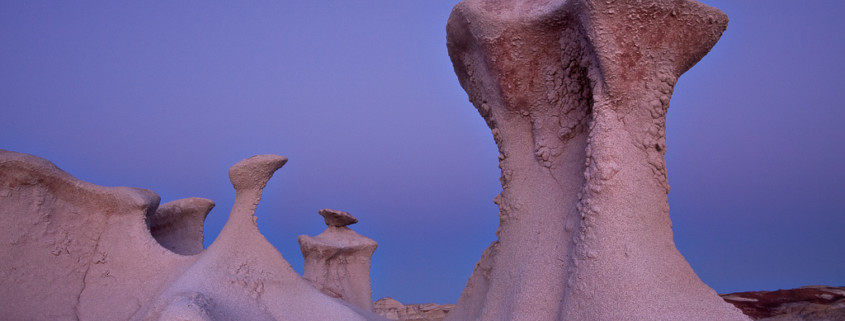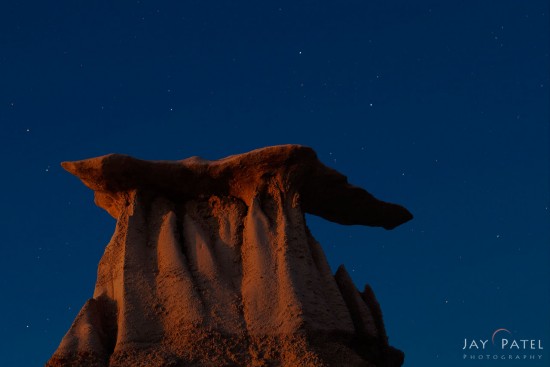A Tale of Two Nights
It’s always fun to try something new. Although both of us have been wanting to do some night photography for a while now, it’s difficult to actually get out there and DO it. Not too long ago, we finally did do it while we were visiting Arizona and New Mexico. Here are a few of our attempts. What do you think?
This shot, titled “The Night Flight”, is a digital blend of two images from Bisti Wilderness in New Mexico. The image was created using a technique Jay calls “Painting with Time”, and no artificial lighting was used. He took one shot just as the last light was falling on the hoodoo – soft, directional lighting gives the formation a soft, golden glow. After taking the first shot, Jay left the camera and the tripod in place. Soon, the stars came out, and he adjusted the exposure to capture their light. (F5.6@25s, ISO 500). Later, he combined the images in Photoshop to create the final image you see above.
Varina chose a simpler technique that evening at Bisti. She wanted to capture the soft curves of the landscape with some very subtle lighting. Shortly after sunset, she used a 3.2 second shutter speed to capture these smooth hoodoos. The sky glowed with a soft magenta light in the West, and the reflected light created the slight color cast you see in the image.
We also tried some night photography in the Vermilion Cliffs in Arizona. Jay’s shot is titled “A Night at The Control Tower”. This is an example of light panting. Although we generally prefer natural lighting, we find that a bit of artificial light can work well alongside ambient light. In this case, the ambient light was provided by the moon. Jay used a 30 second exposure (F4, ISO 200) to underexpose the scene by about 1.3 stops. He wanted to avoid a longer shutter speed, since it would result in “star trails”. He used a headlamp to light The Control Tower as he waited. Matching the exposure for the foreground and the background required some experimentation.
While Jay was busy painting with light that night, Varina climbed high on the rocks in the dark to find a spot that offered an interesting view from above. She wanted to capture the glow of residual light on the bizarre Southwest landscape. In order to capture enough light, she used a whopping 266 second shutter speed (F16, ISO 100). (Though she could have reduced that long shutter speed by increasing the ISO.) The weird colors in the rock were enhanced by the very faint magenta glow in the western sky.
Light Painting, “Painting with Time”, star light and star trails, moon light, residual light… your options are wide open! Have you tried shooting after dark?







Here is a shot that I did recently here in Qalat, Afghanistan. Nothing like taking start trail shots with an M-16, 30 rounds of 5.56mm ammunition, and the Romanian army wondering what you are doing with a camera at night. ~80)
Hope you like it…
Star Trails at the Front Gate
Great shot, Bryan! And quite a story to go with it! I can’t say I’ve had a similar experience. ;) Thanks for the comment and the photo! But more than that – thanks for what you are doing out there. We’re awfully lucky to have guys like you. You have my heartfelt thanks.
This is a fantastic shot, Ron! The light from the fire is incredibly beautiful – and the shot really strikes a chord! Really nice work!
Here's another method, but I only recommend it when mother nature gives the go ahead. This was the Bear Paw Fire last fall in the Tetons. After shooting a sunset, I drove toward Jenny Lake to try to find a vantage point to shoot the fire. Fortunately I found a spot where the fire, Mt. Moran, and the Big Dipper lined up. Shot at f/4, ISO 800, and 50 sec. exposure. I tested a few shots to get the focus–I used the silhouette of the trees and checked it on the back of the camera.
http://www.landscapelight.us/images/BearPaw.html
Great shots, Chris! My favorite is the first cactus shot. And I love the fact that you used the light from your cell phone to add a bit of soft lighting. That's awesome!
Thanks for the comment – and for sharing your work. I know others will enjoy seeing some of your images. I took a look at some of the other photos on your blog. You have a fantastic variety! It was fun to take a look around. Thanks!
Hi Varina and Jay – I really enjoy your postings. It is fun to read your stories behind the great images.
I like to work with night exposures when I have the time as well. I was able to get out a bit for some longer exposures a couple of weeks ago while on a short vacation. Here is the link to a few of the experiments that turned out: http://www.chrismartinphotography.wordpress.com
The two ocean and rock photos were both 237 second exposures at f/11 and ISO 200. There is non-ambient light from a nearby beach house. The cactus shots were both 30 seconds and ISO 200 with light painting on the trunks using my phone in combination with moonlight.